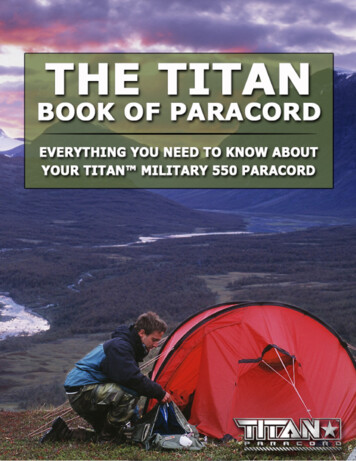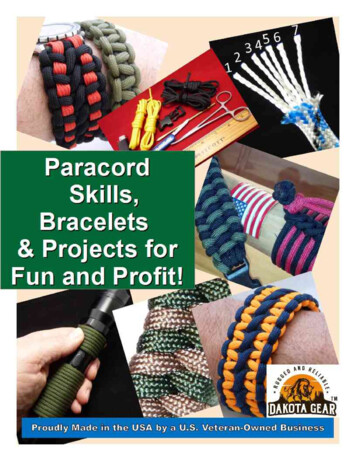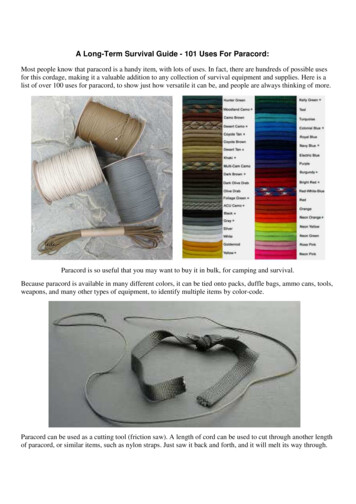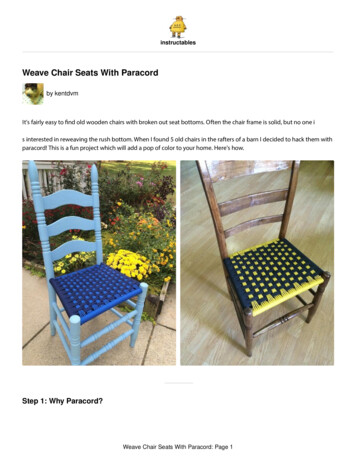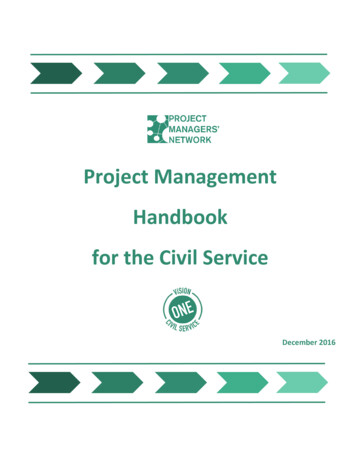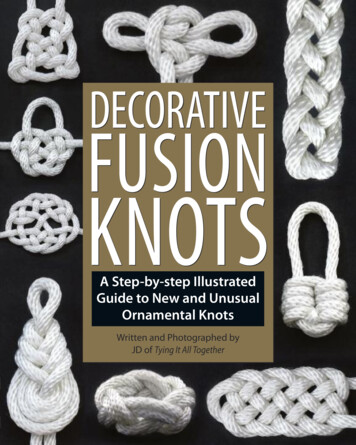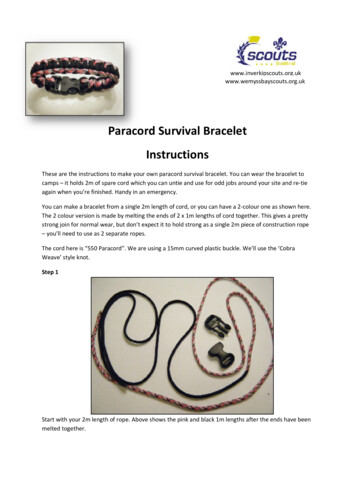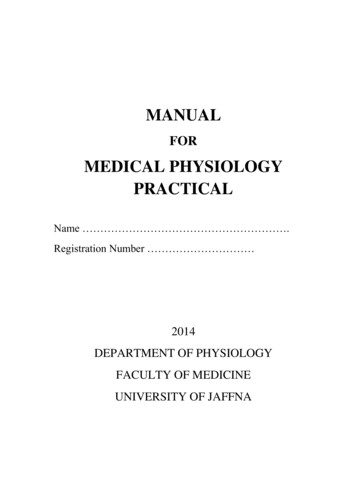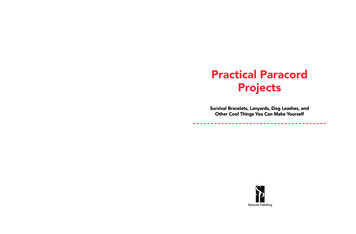
Transcription
Practical ParacordProjectsSurvival Bracelets, Lanyards, Dog Leashes, andOther Cool Things You Can Make YourselfSkyhorse PublishingPractical Paracord Projects Sample.indd 2-327/01/14 3:58 PM
TABLE OF CONTENTSJEWELRYCopyright 2014 by Instructables.comAll rights reserved. No part of this book may be reproduced in any manner without the express written consentof the publisher, except in the case of brief excerpts in critical reviews or articles. All inquiries should beaddressed to Skyhorse Publishing, 307 West 36th Street, 11th Floor, New York, NY 10018.Skyhorse Publishing books may be purchased in bulk at special discounts for sales promotion, corporate gifts,fund-raising, or educational purposes. Special editions can also be created to specifications. For details, contactthe Special Sales Department, Skyhorse Publishing, 307 West 36th Street, 11th Floor, New York, NY 10018 orinfo@skyhorsepublishing.com.BraceletBracelet with BuckleWide BraceletSawtooth BraceletAdjustable BraceletOat Spike BraceletHeart PendantNecklaceRingMonkey’s FistxxxxxxxxxxxxxxxxxxxxSkyhorse and Skyhorse Publishing are registered trademarks of Skyhorse Publishing, Inc. , a Delawarecorporation.Visit our website at www.skyhorsepublishing.com10 9 8 7 6 5 4 3 2 1Library of Congress Cataloging-in-Publication Data is available on file.ISBN: 978-1-62914-757-4Printed in ChinaDisclaimer:This book is intended to offer general guidance. It is sold with the understanding that every effort was madeto provide the most current and accurate information. However, errors and omissions are still possible. Anyuse or misuse of the information contained herein is solely the responsibility of the user, and the authorand publisher make no warrantees or claims as to the truth or validity of the information. The author andpublisher shall have neither liability nor responsibility to any person or entity with respect to any loss ordamage caused, or alleged to have been caused, directly or indirectly, by the information contained in thisbook. Furthermore, this book is not intended to give professional dietary, technical, or medical advice. Pleaserefer to and follow any local laws when using any of the information contained herein, and act responsiblyand safely at all times.KEY CHAINS, LANYARDS,AND OTHER WEARABLEACCESSORIESxxxxxxxxxxxxxxxxxxxxxxKey ChainHeart Key FobCross-Knot LanyardSnake-Knot LanyardEyeglass LanyardWatchbandBeltGerm GrenadeLaptop HarnessSandalsHelmetvPractical Paracord Projects Sample.indd 4-527/01/14 3:58 PM
HIKING AND CAMPING ACCESSORIESTOYSSlingArmy ManArmy Man RifleArmy Man Radio BackpackArmy Man ParachuteHorseOctopusParacord GuysBullwhipviPractical Paracord Projects Sample.indd 6-7xxxxxxxxxxxxxxxxxxCrampon HackDrawstring PouchWater Bottle HolderBottle Strap FixLeatherman PouchStrap WrapFishing LureCompression SackKnife HandlexxxxxxxxxxxxxxxxxxPET ACCESSORIESHOUSEHOLD ITEMSxxxxxxxxxxxxxxxxxxxxxxDog LeashPet HarnessDog CollarChairHanging ChairBookBookmarkCan KoozieWrapped DrumsticksGuitar StrapParacord Holdervii27/01/14 3:58 PM
Practical Paracord ProjectsJewelryBraceletBracelet with BuckleWide BraceletSawtooth BraceletAdjustable BraceletOat Spike BraceletHeart PendantNecklaceRingMonkey’s FistPractical Paracord Projects Sample.indd 8-127/01/14 3:58 PM
Bracelet with BuckleBy dbracelet-with-a-side-release-buckle/)This tutorial will show how to make a paracordbracelet with a side-release buckle. When made ona larger scale, you can make this for use as a dog orcat collar as well. A reliable online source of paracordis the Supply Captain, and for side-release buckles Irecommend Creative Designworks.3Practical Paracord Projects Sample.indd 2-327/01/14 3:58 PM
practical paracord projectsbracelet with buckleThe amount of cord used can vary, but for thisexample, we’ll use 10 feet of paracord to startwith. Actual amount of cord used for the bracelet isabout one foot of cord for every one inch of knottedbracelet length. So if your wrist is 8 inches, you’d useapproximately 8 feet of cord.Step 2: Measure WristWrap the paracord around your wrist and make anote of where the cord meets. Hold this point next toyour ruler or tape measure, and that’s your wrist size.Step 1: MaterialsYou’ll need: Paracord, or equivalent 1/8“ diameter cord Tape measure or ruler Scissors Side-release buckle Lighter (torch lighter works best).4Practical Paracord Projects Sample.indd 4-5Step 3: Find the Center of the CordHold the ends of the cord together and find thecenter of the loop. Take the center of the cord and527/01/14 3:58 PM
practical paracord projectsbracelet with bucklepull it through one end of the buckle (either side ofthe buckle, it doesn’t matter). Now pull the cord endsthrough the loop until it’s tightened up and attachedto the buckle.Step 5: Start Making the KnotsThe knot used for the bracelet has a few differentnames—cobra stitch, Solomon bar, and Portuguesesinnet. Take the cord on the left side and place itunder the center strands running between the buckleends. Now take the cord on the right side under theleft-side cord, over the center strands, and throughthe loop of the left-side cord. Tighten up the cordsso the half knot you just formed is next to the buckle.Now take the right-side cord under the centerstrands. The left-side cord goes under the right-sidecord, over the center strands, and through the loopof the right-side cord. Tighten up the cords (nottoo tight, just until they meet the resistance of theknot) and now you have a completed knot. You willcontinue, alternating the left and right sides as yougo. If you don’t alternate, you’ll quickly see a twistingof the knots, and just undo the last knot and beginalternating to correct.Step 7: Trim the Excess Cord and Meltthe EndsYou can now use your scissors to trim off theextra cord close to the last knot you tied. I trim oneat a time and use my lighter to quickly melt the end Icut, wait a second for the melted cord to cool just abit, and then use my thumb to press the melted endonto the surrounding cord so it hardens as it coolsand attaches. You must be careful with this step. Themelted cord is extremely hot, and it’s possible toget burned, so you might also try using a solderingiron or woodburning tool for the melting step if youwish, or you could even use something like a butterknife, the side of your lighter, or the knurled sectionof a tool to flatten out the melted end of the cordto finish it.An alternative to melting the ends is to tuck/pullthe ends under the last couple of knots. I have usedhemostats to do this on the inside of the bracelet,then trimmed them to finish. It does work, and is justbarely noticeable, as the cords add a slight bulge atthat end of the bracelet.Step 4: Finding the Bracelet LengthTake the buckle apart and pull the free ends ofthe cord through the other part of the buckle, slidingit up toward the attached part. You’re going tomeasure the distance between the two buckle endsfor the bracelet size for your wrist. Add about oneinch to your measured wrist length; this will make thefinished bracelet a comfortable fit. You’re measuringfrom the end of the female part of the buckle to theflat part of the male end of the buckle (the part withthe prongs; they don’t count for the measurementbecause they fit inside the female part of the bucklewhen the bracelet is closed.).6Practical Paracord Projects Sample.indd 6-7Step 6: Continue KnottingKeep tying the knots until you have filled thespace between the buckle ends. The knots should beuniform from one end to the other. Tie each knot withthe same tension to keep them all the same size.727/01/14 3:58 PM
practical paracord projectsbracelet with bucklestrands around second buckle (at your wrist size),back to and around first buckle (now has four strandsaround), then back to and around second buckle, andstart knotting around the six core strands. This givesextra cord in case you need it for whatever, but italso makes the paracord bracelets thicker and morerounded, which I personally didn’t care for and that’swhy I stick with the two strand core.Step 9: Other VariationsOnce you have the hang of the basic bracelet/collar, you can add another layer of cobra stitchesoverlapping first set of knots, called a king cobrastitch/doubled Solomon bar/doubled Portuguesesinnet. The amount of cord used for a king cobra isabout twice as much as for the regular stitch. Boththe 1/16“ and 3/32“ sizes work well for the braceletsand can be used alone or combined with paracord.Glow-in-the-dark paracord is available now, foundfrom various online vendors and on ebay, but I haven’tused any myself, so I couldn’t say if it’s any good ornot, or how long it glows, etc.Step 8: You’re FinishedIf you did everything correctly, it should looksomething like this finished one. Once you know whatyou’re doing, you can vary the amount of cord usedby making the knots tighter or looser and pushingthe knots closer together as you go.A tip for paracord bracelets: If the side-releasebuckle is large enough, you can loop the paracordaround it again before you start knotting to fill inthe extra room on the buckle. The 1/2” side-releasebuckles are a tight fit for this, but will work, and the5/8” size is just right. This leaves a two-strand corefor the bracelet when you start knotting. Now, youcould also have a four-strand core by starting with alark’s head on the first buckle end, double wrappingon the second buckle end (at your wrist size), runningcord back to and over the first buckle end, thenstarting to knot over the four-strand core. Or, for asix-strand core, lark’s head first buckle, run the two8Practical Paracord Projects Sample.indd 8-9927/01/14 3:58 PM
bracelet with buckle10Practical Paracord Projects Sample.indd 1027/01/14 3:58 PM
Skyhorse Publishing books may be purchased in bulk at special discounts for sales promotion, corporate gifts, fund-raising, or educational purposes. Special editions can also be created to specifications. For details, contact the Special Sales Department, Skyhorse Publishing
